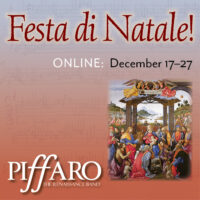This Guest Editorial was first published in the January, 2025, issue of EMAg, the Magazine of Early Music America
Growing up in a very musical family in Bolivia, I was exposed to a range of genres from a young age. My earliest musical memory involves my mother (a choir conductor) and my father (a specialist in traditional Andean instruments) singing and playing villancicos on the charango, an Andean plucked string instrument. My siblings and I would dance in front of the nacimiento, our little nativity scene, before opening presents on Christmas Eve.

My exposure to European period instruments came later, as a young violin student, attending concerts of the Festival Internacional de Musica Barroca y Renacentista Americana, known as “Misiones de Chiquitos.” I listened in awe to the sounds of those weird instruments, including the chirimías, bajones, and baroque violins. But it was not until I moved to the U.S. for university that I was able to put my hands on period instruments. During my studies in historical performance (HP) — in Cleveland, London, and Montréal — I studied music by the celebrated European composers, learning rules and historical conventions from treatises and teachers. But in the back of my mind, I kept wondering: Where were the Chovenas, taquiraris, cuecas, and tonadas I grew up singing and dancing? Aren’t these early music, too?
This past summer I was honored to be elected board president of EMA. As we celebrate 40 years of service and support for the field — and launch our looking-forward Funding the Future campaign — I dare to make a wish for that future. My wish for EMA is one of continuous expansion: our awareness of each other within the field, our scholarships and support for young talent to increase in numbers, our reach and service to include Latin America, and the definition and the scope of our art to include historical traditions and practices from around the world.
We use terms such as “traditional” or “folk” to refer to the music I grew up hearing in Bolivia, all correct and learned, just as we know that much of that music stems from centuries-old traditions. I cannot stop thinking that I am very lucky to have had such rich musical upbringing. I can only wish HP students nowadays would have a somewhat similar experience and be exposed to as many genres, styles, and performance practices from as many cultures as possible. I have seen with excitement how some music schools have offered the ad-hoc fiddling session (when such musicians are in town) which has sometimes led to students forming fiddling clubs. I have also seen schools hosting the one-time guest who introduces non-Western practices. But could this be part of the curriculum, rather than an exotic add-on?
Certainly exoticising these repertoires and practices has othered them and we need to change that. We can start by being more aware of how the way we refer to music impacts its reception, and move away from loaded terms like “New World,” for example (which is stuck in the idea of “discovery” and the supremacy of the “Old World”) and find ways to refer to music composed in our continent that indicates time (e.g. 18th century), historical period (e.g. colonial, post-colonial), or geographical location (e.g. South American).
In this same vein, I propose we present HP students with “global early musics” — an approach that presents early music from around the world within its historical and cultural context. It would be wonderful to see amazing musicians such as Kiya Tabassian (from the ensemble Constantinople) or Abel Rocha (from Trio Guadalevín), or many others, as artists-in-residence at HP programs offering year-long explorations as part of the curriculum.
Big dreams for a bright future! In the meantime, let’s keep working together to support our field in its ever-expanding reach as we increase our awareness of each other — in all our interconnectedness and our globality.
Karin Cuéllar Rendón is a Bolivian historical violinist and researcher currently residing in Montreal.

